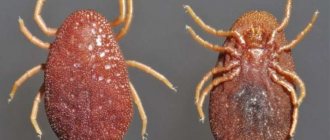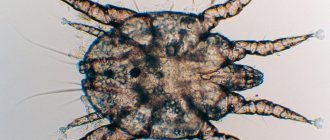The term dog tick can mean either simply a tick that has bitten a dog, or a separate species of tick that has that official scientific name. You can read more about tick bites on dogs here
, then we will talk about dog ticks as a separate species of these insects.
The dog tick or European forest tick (Ixodes ricinus) is a representative of the Ixodes tick family - the most widespread in Russia. This species is capable of biting any warm-blooded creatures - people, cats, dogs, ungulates, rodents, wild animals and birds. The species' habitat covers all of Europe, part of Scandinavia, the Southern, Central, Volga and part of the North-West region of Russia. What does this pest look like and how does it differ from other commonly encountered representatives of its family?
Dog tick: photo
The dog tick is an arachnid and in its structure, appearance and movements one can indeed find many similarities with spiders.
- The size of a hungry tick varies between 2–4 millimeters; females are usually larger than males.
- The color of the back is brown, with a brown or almost black circle halfway across the body from the head and below.
- The body of the tick is flat, together with its head it has a teardrop shape.
- The tick has 4 pairs of long legs.
- Well-fed ticks increase in size to 1–1.2 centimeters in diameter.
- The torso turns gray due to stretching of the tissues and blood inside the parasite.
- Once engorged with blood, the tick becomes round and shaped like a shiny bean with short legs sticking out in front.
Fortunately, dog ticks do not move as quickly as some types of spiders, so if you notice an insect on yourself or your pet that resembles a tick in shape, you can simply brush it off before the parasite finds a place to attach itself. If you doubt that you are faced with this particular species, look at what a dog tick looks like in the photo and, additionally using the description given above, try to more accurately identify the pest.
How does scabies appear in cats?
Invasive scabies infection in the cat family is fundamentally different from the human disease caused by a parasitic mite. An accurate diagnosis can only be made by a veterinarian based on a visual examination of the animal and the results of skin scraping analysis. The specialist will determine the type of scabies parasite, explain safety measures for the owner and prescribe treatment for the pet. There are three types of ticks in cats:
- Cheyletiellosis (scientific name Cheyletiella) - can be transmitted to humans, lives on the entire surface of the animal’s body.
- Notoedres - starts in the head area, provokes the formation of purulent crusts and hair loss. Can be transmitted to humans.
- Red-bodied tick (Trombicula) - chooses to live on the hind limbs of the body of cats, and can also be transmitted to humans.
In the initial stage, scabies appears in the neck, head and ears of the pet. Over time, the parasites spread over the entire surface of the animal’s body and lay eggs. In this regard, the aching itch worries the pet more and more, scratches and wounds appear on the skin, and the hair in these places falls out. In cats, scabies is accompanied by the following symptoms:
- increased anxiety and nervousness;
- refusal of usual food and water;
- aggressive behavior for no apparent reason;
- severe itching and increased scratching;
- hair loss;
- the appearance of purulent scratches on the surface of the skin.
If timely assistance is not provided, the disease progresses and the animal’s general condition becomes noticeably worse. Individuals with reduced immunity who have undergone a serious illness or surgery are at greater risk. In such cases, scabies may appear again and be more severe.
Dog tick: life cycle
Ticks are oviparous insects. The female, engorged with blood, lays from several hundred to several thousand eggs at a time. She places them at ground level - in humus, fallen leaves, topsoil, compost, firewood, dumped garbage, on tree roots and in other secluded places. The clutches look like clusters of small dirty yellow eggs, somewhat similar to small eggs.
- The incubation period of eggs lasts from 2 weeks to 2 months.
- Dog tick larvae are similar to adult ticks, but are smaller in size - up to 0.2 millimeters in length.
- At this stage, the insect spends from 1 week to 1.5 months, and then turns into a nymph.
- Nymphs look the same as adult ticks, but are still smaller in size - up to 1 millimeter in length.
- To move from one stage to another, an insect needs to be saturated with blood; its viability at each stage depends on this.
- The larvae feed on the blood of small rodents and burrowing animals that burrow into or live in the ground.
- Nymphs are able to climb to the surface, but rarely rise above 20 centimeters from it; here larger rodents and animals are added to their diet.
- After turning into an adult insect, the tick lives for 1–2 years, bears offspring and dies.
- In total, dog ticks can live up to 8 years.
The rate at which the dog tick grows and its life cycle as a whole depends on the climatic conditions where the insect lives, the characteristics of the current season and other external circumstances. The development cycle from hatching from an egg to the reproduction of an adult can occur in as little as 1 year or last for 4–6 years. When it gets colder, ticks at any stage of development are capable of falling into suspended animation and temporarily suspending their vital activity until conditions become more suitable for this. Adult insects, larvae, and nymphs can hibernate.
Preventive methods of controlling parasites
It is better to prevent any disease than to treat it, but it is impossible to isolate yourself from the whole world. Even if your pussy sits at home, you can infect it by bringing mites on your clothes or the soles of your shoes. Compliance with preventive measures includes:
- Minimizing contact with stray animals;
- Balanced nutrition for the pet - dry food should be at least premium, and homemade food only from high-quality products;
- Regular examination of the animal's fur and skin - first of all, the groin area, ears, armpits;
- Maintaining hygiene - cleaning bowls, toys and beds.
- Cat breeders should not separate kittens from their mother for up to two months - along with milk, the offspring receive passive immunity, which protects the animal from pathogenic organisms.
It is advisable to sterilize pets who have recovered from the disease in order to avoid hormonal imbalances, complicated by relapses in the future. If a cat is carrying kittens and at the same time has contracted scabies, there is a possibility of giving birth to offspring with pathologies. Compliance with hygiene rules and basic prevention will reduce the risk of infection for your pet.
Dog tick: diseases
By biting various warm-blooded animals, ticks become carriers of diseases that have infected their carriers. When ticks bite, they can transmit these bacteria and viruses to people and animals. Many of them, without treatment, lead to death, and this is the main thing that makes any tick dangerous.
A dog tick with a bite can transmit the following diseases:
- Tick-borne encephalitis
- Lyme disease or borreliosis
- Tularemia
- Marseille fever
- Various types of tick-borne typhus
- Babesiosis
- Rickettsial diseases
- Monocytic ehrlichiosis
If, after a bite, these diseases are identified in the early stages and their treatment is started even before the first symptoms appear, most often, they can be completely cured. According to official statistics, mortality rates due to tick bites are low and mainly concern isolated remote regions where people chose not to seek medical help at all or did it too late.
For early detection of diseases, the attached tick, after it is removed from the body, must not be destroyed, but submitted for analysis. If harmful viruses or bacteria are found in the insect, doctors will be able to begin treatment even before your first symptoms appear.
Protection and safety measures
During the active season for dog ticks (from May to November), it is worth regularly using protective equipment, such as anti-tick medications and pet collars. If possible, you should avoid places where parasites can be found - areas with tall grass, forest and forest-steppe zones. However, none of the methods of protection can guarantee that contact with a tick will not occur. Therefore we recommend:
- combine several methods of protection at once (treat things with acaricidal agents, wear special suits in the forest, protect pets with anti-tick drugs and vaccinate them on time);
- when walking in a forest, park or other potentially dangerous area , inspect yourself and your pet every 40–60 minutes; if you are walking in a group, conduct mutual examinations (before biting, the tick crawls along the body and selects a suitable place for about 30 minutes, during this period it is easy to prevent the bite);
- After a walk, carefully examine your pets, yourself and your clothes.
If you find a tick on your dog or yourself, do not panic and do not try to crush it or tear it off. In this case, keep a Tick Card , with which you can easily and safely remove any attached tick. Do not handle the parasite with your bare hands, even after removing it from your body. Put it in a test tube and take it to the laboratory for analysis within 2 days - it’s better to find out right away whether this tick was contagious and whether you should worry about your health.
Dog tick: harm to humans
In addition to the danger of transmitting pathogenic viruses and bacteria that threaten human life and health, tick bites themselves can also cause many problems.
- A person usually does not feel the immediate moment of the bite, but over time a throbbing pain may begin to appear.
- If the tick is removed incorrectly, the head of the parasite may remain in the wound and the bite will begin to fester.
- An allergy may appear to a dog tick bite, its intensity and what kind of allergy it will depend on the individual characteristics of the body.
- Tick bites can be very itchy.
- By scratching them, you can additionally introduce any infection into the wound with your own hands.
- Scars and welts may remain at the site of heavily scratched bites.
With weak immunity, sensitivity and chronic diseases, a dog tick bite can:
- Temperature rises
- Feeling dizzy
- Shortness of breath and other breathing problems occur
- Feel general weakness in the body
- Nausea and vomiting appear
- Feeling heavy in the chest
The dog tick is undoubtedly dangerous to humans, but it can pose no less, and sometimes even greater, threat to domestic animals.
Diagnosis and treatment
To accurately determine the type of tick, a specialist must scrape it and send it for analysis. This is done in order to exclude diseases with similar symptoms - eczema, allergies, dermatitis or lichen. Drug therapy for a four-legged patient lasts on average from one to three weeks. Special shampoos, sprays, ointments, as well as oral medications of various forms (drops, syrups, tablets) are used as treatment. The approximate treatment formula looks like this:
- treating the affected surface with a gentle antiseptic - hydrogen peroxide, miramistin, chlorhexidine;
- taking antibiotics to prevent the risk of developing a secondary infection;
- use of acaricides to control insects;
- taking antihistamines to relieve itching;
- stimulating the work of immune cells with the help of vitamin complexes.
Particular attention should be paid to antiparasitic treatment. The dosage and drug should be determined by the doctor, taking into account the health characteristics of a particular animal. The effectiveness of the prescribed therapy will depend on the accuracy of the procedures recommended by the specialist. Even skipping a medication once will delay the healing process indefinitely.
Dog tick: harm to cats and dogs
Cats and dogs are ideal prey for ticks since they live within the same altitude as the insects. Ticks can sometimes be removed literally in clusters from pets that have not been protected from parasites. Most often, parasites bite animals in the area of the auricle, head, withers, neck or stomach. Cats
, as a rule, rarely catch any diseases from ticks, except Babesia felida. The dog tick can cause much more harm to canines.
Dogs can be infected with piroplasmosis, encephalitis
, anaplasmosis, monocytic ehrlichiosis and borreliosis, and in 98% of cases, without medical intervention and the necessary treatment, the animal will die, so it is so important to immediately contact a veterinarian and notice any signs of changes in the dog’s well-being if it has been bitten by ticks.
How is scabies transmitted to humans?
For infection from a sick animal, ordinary contact is sufficient. For example, a child who pets a stray animal on the street becomes a carrier of scabies mites. Infection can also occur if a free-ranging pet brings parasites home. However, not all types of cat scabies are dangerous to humans, among them:
- Hair mites are able to survive exclusively in animal fur; human skin is not suitable for their life and reproduction.
- Parasites that can live on the human body for no more than two days - in this way, insects only move long distances and, not finding a more suitable host, die.
- Small mites that appear during the period when the cat’s immune system is weakened are relatively harmless to a healthy person.
In medical circles, there is a special term that characterizes infection from a cat to a person - “pseudo scabies.” The fact is that ticks that carry invasive diseases can only comfortably exist on a cat’s body. Parasites can only stay on human skin for a short time, causing discomfort. Despite their apparent harmlessness, scabies mites can cause a lot of trouble, for example:
- feeling of discomfort;
- dryness and severe peeling of the skin;
- pimples and ulcers;
- cortical formations.
Pseudo scabies is not transmitted between people and goes away on its own, without medical intervention. If the above symptoms cause severe concern, you should consult a dermatologist.
Signs of a tick bite
At first, the pet may look healthy, so it is so important to examine the animal after each walk to rule out a parasite bite.
The most common symptoms of infection include:
- general lethargy;
- lack of appetite;
- darkening of urine (this is one of the surest signs);
- inactivity;
- vomiting and diarrhea;
- strong thirst;
- high body temperature;
- pallor of the mucous membrane.
If you notice any of the above, seek help as soon as possible and take all necessary tests. Remember that even after treatment, the disease can relapse, so monitor your pet’s health.
Why are they dangerous?
Ixodid ticks carry diseases such as:
- tularemia;
- tick-borne encephalitis;
- borreliosis (Lyme disease);
- anaplasmosis;
- babesiosis (pyroplasmosis);
- typhus;
- relapsing fever and others;
From this entire list, dogs can become infected through a tick bite with babesiosis (pyroplasmosis), anaplasmosis and borreliosis (Lyme disease). Tick-borne encephalitis in dogs is a myth; dogs do not get sick from this dangerous disease for humans.
Myth. If everything is fine within 2 weeks after the tick bite, it means it’s gone.
In fact . Unfortunately no. And if tick-borne encephalitis most often occurs with obvious symptoms, then borreliosis occurs in a latent form in approximately 20% of cases. In addition, it comes in three types: cutaneous, articular and neuroborreliosis (the latter is the rarest and most dangerous). However, after removing the tick, it is extremely important to monitor your condition and the wound for several days. If a purple spot or circular erythema (a scarlet or purple circle around the wound) appears at the site of the bite - signs of the acute phase of borreliosis - it is important to immediately contact an infectious disease specialist. At an early stage, you can recover in a week. But articular and neuroborreliosis, which manifests itself only several months after infection, are difficult and long to treat.
How to tell if your dog is sick
According to our long-term personal observations, dogs experience either acute or chronic piroplasmosis. We encounter acute piroplasmosis more often, so let's talk about it.
The first thing you should pay attention to is the dog’s elevated body temperature. At first it can reach 41–42°C. But the most dangerous time comes a few days later, when the temperature drops to 35–36°C. The owner thinks that the pet has recovered, when in fact the disease is only gaining momentum.
The normal temperature for a dog is 37.5–39°C. Correctly measure temperature by inserting the tip of the thermometer into the rectum. This method is called rectal.
If you notice an elevated temperature → call +7 (495) 66-55-408.
In acute piroplasmosis, the dog's urine becomes red, and there is often diarrhea, vomiting and constipation. We recommend paying attention to poor appetite. A dog rarely refuses his favorite food because of his mood.
An animal with acute piroplasmosis breathes heavily and rapidly. The previously cheerful pet begins to walk with difficulty. Instead of the usual activity - a sluggish gait.
You know better than anyone how your dog behaves every day. No doctor will tell you what is normal for your dog and what is not. Therefore, as soon as you notice abnormal behavior, consult your veterinarian.
How to remove a tick
During the warm season, examine your pet daily, even if the dog has been treated for parasites. If you find a tick, do not smear it with oil - this grandfather's method does not work. The tick must be removed. The best way to do this is to use a special tool - a twister. They are sold at any pet store. Every pet owner should have one in their first aid kit. When using tweezers or trying to remove a tick manually, there is a high risk of tearing off and leaving the proboscis in the wound. It is better to avoid this, as inflammation will temporarily develop in this area.
If you doubt your abilities, contact your nearest veterinary clinic. The specialist will remove the tick quickly and without consequences, and at the same time carry out all the necessary tests to exclude infections transmitted by the tick.
What to do if you find a tick on an animal?
If a tick has already attached itself to your pet, it is necessary to remove it as soon as possible. Remove the tick with tweezers, a surgical forceps, thread, or, as a last resort, put gloves on your hand and remove the parasite. You should not do this without protection, since ticks carry dangerous diseases to humans.
Please note that stores now sell special tick removers or devices for removing ticks. With their help, it is quite simple to grab the tick as close to the proboscis as possible and twist it in a circular motion until it jumps out of the wound. In any case, the principle of action for removing the parasite is the same.
Do not leave the tick head in the animal's body. If it so happens that the proboscis remains separate, then it needs to be removed like an ordinary splinter.
After removal, treat the wound with any disinfectant.
The parasite should be burned or placed in a jar and taken to the laboratory so that specialists can determine whether it was a carrier of diseases.
Be sure to monitor your pet's condition.
How much does treatment actually cost?
Let's look at prices and conditions using Biovetel as an example:
- Calling a veterinarian to your home costs 2,500 rubles.
- If a paramedic goes, the call will cost 1,500 rubles.
- Blood sampling - 500 rubles.
- Blood smear for analysis for piroplasmosis - 700 rubles.
- Delivery of the analysis to the laboratory - 850 rubles.
- Consumables: gloves, test tubes, needle, bandage - 100 rubles.
- Total: 3550–4650 rubles.
What's included in the price:
- Arrival of a doctor or paramedic.
- Full clinical examination of the animal. You will never hear from us that you will have to pay extra for measuring your temperature or pulse rate.
- Filling out the medical history form. We leave the original to you.
- Making a preliminary diagnosis.
- Prescription of treatment with a description of the necessary drugs, dosages and frequency of use with an entry in the medical history.
- Consultation on test results, if you have them.
- Consultations on feeding and keeping an animal during illness.
You will not have to pay to call the doctor again based on test results. The doctor himself will call you back, comment on the results and adjust the prescribed treatment. We will send you all appointments by email.
Types of forest ticks
The most common and dangerous to humans on the territory of the Russian Federation are ixodid ticks, which are also called forest ticks or encephalitis ticks. Its usual size is no more than 1.3 cm, but when it is full, the individual becomes almost twice as large - about 2.5 cm. When bitten, the first thing to do is inject a painkiller into the wound, which lasts for 5-6 hours, which is why during the bite and when the tick is saturated with blood, the victim does not feel anything.
Dimensions of a hungry and well-fed female tick
Interesting fact! It’s hard to believe, but in the process of sucking blood, the female tick (and it is she who attacks) is capable of drinking a volume of blood that exceeds its weight by more than 100 times!
Argas mites are also known - they live in the cracks of houses and their lifestyle is more reminiscent of bed bugs. These bloodsucking creatures can become carriers of spirochetosis - in other words, tick-borne relapsing fever.
Invisible argas mites live in the cracks of houses
Oribatid mites live in soils and are carriers of tapeworms, which infect sheep, cows and other herbivores.
Soil-dwelling oribatid mites
Barn mites (bread mites, flour mites) – they almost never attack humans, preferring insects.
The body of a granary mite is usually beige or white in color.
Attention! The forest tick (see photo) does not attack at temperatures below +10-12C, including at night and in the evening. Also, these arachnids do not like humidity (they do not attack until the dew dries), and in the hot season they prefer to be active in the morning and evening. The peak of tick activity coincides with the period when buds bloom on birch trees.
The forest tick looks like an arachnid insect











